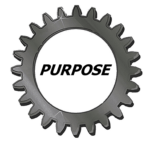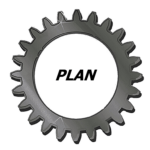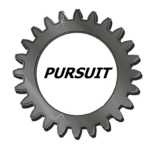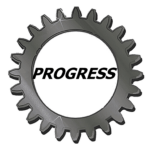Business Model Canvas
The Business Model Canvas allows businesses to visualize, analyze, and optimize their entire business model in one comprehensive framework. Encourages collaboration and communication and allows businesses to tap into the collective expertise and insights of their teams.

Chapter 1: What is it?

The Business Model Canvas is a strategic management tool that provides a visual representation of a company’s business model. It was introduced by Alexander Osterwalder in his book “Business Model Generation” and has gained significant popularity since then. The canvas allows organizations to understand, design, and innovate their business models, enabling them to effectively communicate and align their strategies. By capturing all the essential aspects of a business on a single page, the Business Model Canvas facilitates a holistic view of the company’s operations, creating a foundation for analysis and decision-making.
Chapter 2 : When do I use it?

The Pursuit Business Model Canvas is a dynamic framework that allows entrepreneurs and business owners to map out and analyze the various aspects of their business in a visual and concise manner. Unlike traditional business plans, which can be overwhelming and time-consuming, the Pursuit Business Model Canvas provides a streamlined format that focuses on key elements such as customer segments, value propositions, revenue streams, and key partnerships.
Chapter 3: How do I use it?

Step-by-step guide to using the Business Model Canvas
1. Start by identifying your customer segments. Who are your target customers, and what are their characteristics and needs?
2. Define your value propositions. What unique value does your product or service offer to your customers? How does it solve their problems or fulfill their desires?
3. Determine the most effective channels to reach your customers. How will you distribute and deliver your product or service to your target market?
4. Consider the type of relationship you want to establish with your customers. How will you create and maintain customer loyalty and satisfaction?
5. Identify the revenue streams for your business. How will you generate income from your product or service?
6. Define the key activities required to deliver your value propositions. What are the core actions and processes that drive your business?
7. Identify the key resources and assets needed to operate your business. What are the essential elements required to deliver your value propositions?
8. Determine key partnerships that can enhance your business model. Who are the strategic alliances or collaborations that can help you achieve your goals?
9. Finally, consider the cost structure of your business. What are the main costs involved in delivering your value propositions and running your business?
To master the Business Model Canvas, here are some tips and tricks to keep in mind. Firstly, be open to iteration and refinement. Your business model is not set in stone, and it should evolve as you learn more about your customers and market. Secondly, involve your team in the process. Different perspectives and expertise can contribute to a more comprehensive and well-rounded canvas. Thirdly, consider using sticky notes or digital tools for flexibility and easy modifications. This allows you to experiment and make changes without starting from scratch. Lastly, regularly review and update your canvas to ensure it remains relevant and aligned with your business goals and market dynamics.
Chapter 4 :Why should I use it?

The Business Model Canvas is a powerful tool that allows businesses to visualize, analyze, and optimize their entire business model in one comprehensive framework. Unlike traditional business plans that can be lengthy and rigid, the canvas provides a dynamic and flexible approach. It consists of nine key building blocks, including customer segments, value proposition, channels, customer relationships, revenue streams, key activities, key resources, key partners, and cost structure. By examining each element and their interdependencies, businesses can gain invaluable insights into their operations and identify areas for improvement and innovation.
With the Business Model Canvas, businesses can unleash their full potential. It offers a holistic view of the entire business model, enabling organizations to identify strengths and weaknesses, streamline processes, and develop strategies that align with their goals and objectives. By visualizing the various components and their relationships, businesses can uncover new opportunities, identify potential risks, and make informed decisions that drive growth and success.
Moreover, the Business Model Canvas encourages collaboration and communication within an organization. By involving key stakeholders in the process, businesses can foster a shared understanding of the business model and align everyone towards a common vision. This collaborative approach not only enhances problem-solving capabilities but also promotes innovation and creativity. It allows businesses to tap into the collective expertise and insights of their teams, resulting in a more robust and dynamic business model.
Chapter 5 : Collaborative Benefits
Not all help costs money. Requests for additional information and potential application for your industry, helps us to improve the training experience, at no charge to you.
When do I need collaborative services?
Collaboration has proven time and time again to be a powerful tool in optimizing performance and driving efficiency in various aspects of life. Whether it is in the workplace, educational settings, or even within personal relationships, collaboration has the ability to unlock untapped potential and enhance productivity. By leveraging the collective intelligence and diverse skills of a group, individuals can capitalize on their strengths, overcome challenges, and achieve remarkable results.
What do I get with collaborative services?
Our Role – Quality coordinating – Analyze your system, review your policies, and suggest process improvements.
We help you use a chosen template and apply it to your business model, with or without action plans.
Course includes a shareable document for use or for future collaboration.
1 hour online training (one on one training) no minimum participates

Download a Business Model Canvas Template
Templates are like a secret weapon in the arsenal of content creators. They provide a foundation, a starting point that saves us time and energy.
Mobile Format
By using Google Docs we offer an extensive selection of free templates, covering various categories with no special apps to download making them truly mobile. These templates are also available in Microsoft Word format. These templates are designed by professionals, ensuring a polished and visually appealing outcome. With a few clicks, we can have a well-structured document, complete with headings, subheadings, and placeholders for our content. These templates act as a guiding hand, making it easier for us to organize our thoughts and ideas effectively. They eliminate the need to spend hours formatting and styling our documents, enabling us to focus on the content creation itself.
Simplify Creation Content
The true power of templates lies in their ability to simplify and streamline the content creation process. By using pre-designed layouts and formats, we can save valuable time and effort. Rather than starting from a blank canvas and grappling with design decisions, we can simply choose a template that aligns with our desired style and purpose. This not only speeds up the creation process but also ensures a consistent and professional look for our content.
Templates also allow for customization, enabling us to personalize the document according to our needs. This level of flexibility empowers us to create visually stunning content without the need for advanced design skills. Templates break down the barriers between creativity and execution, making content creation accessible to all.
Unleash Your Creativity
Effortless content creation is within our reach, thanks to the power of free templates in Google Docs and Microsoft Word. By utilizing these templates, we can simplify our workflows, save time, and produce high-quality content without the need for extensive design knowledge. Unlocking the potential of templates allows us to focus on what truly matters – our ideas, thoughts, and messages. So why start from scratch when we have a vast library of templates waiting to be explored? Embrace the convenience and unleash your creativity by utilizing the power of free templates in your next content creation endeavor.
What is a Business Model Canvas?
Watch this Video.
The Business Model Canvas (BMC) has become a widely adopted tool for entrepreneurs, startups, and business professionals looking to visualize and develop their business models. Created by Alexander Osterwalder and Yves Pigneur, the BMC provides a comprehensive framework for analyzing and designing business models.
As You Watch This Video
As you watch this video to understand the available template:
1. Customer Segments are the customer or interested parties, basically your target market segment.
2. Value Proposition is the value offerings identified by doing the Free Course Value Proposition Model.
3. Channels are the means by which the values propositions are delivered to the customer or interested parties.
4. Customer Relationships are those means to get to the customer or interested parties.
5. Key Activities are those activities that deliver the value propositions to the customer or interested parties.
6. Revenue Streams are the means by which there is an exchange of value between the customer or interested parties and the organization.
7. Key Resources are those resources needed to convert concepts to value propositions to deliver to the customer or interested parties.
8. Key Partners are those suppliers or interested parties supply needed resources to support the value propositions.
9. Cost Structure is the supplier activities and resources costs needed to support the value propositions.
Still need to visualize, understand the design of the business model canvas and how the method is tested, see the following case studies.

Case Study 1 - Led to Manage LLC
Value Propostion
Website course experience
Free online courses
Free online templates
Free tech support
Website help experience
Collaboration services
Facilitation services
Off Site/On Site Training
Training packages available
(See Purpose Defining Course – Value Proposition Model)
Customers
Tie to the Proposition (see Purpose Defining Course – Value Proposition Model)
Target market (demographics)
>Students of all ages as an introduction to the quality field.
>New quality professionals looking to gain knowledge about quality systems at a low cost point.
>Entrepreneurs needing purpose defining, strategic and tactical planning tools to grow from a single or small company into a larger corporation.
>Small companies needing training on quality tools and concepts at a low cost.
If you need certificates of completions, become a CMI, CQE, Six Sigma green or black belts or assistance to certify to ISO9001 or any other standards, contact us we can help direct you to resources to get you started on your journey.
Cost Model
$ Collaboration services
Discounts available contact us for more information.
Our Role – Quality coordinating – Analyze your system, review your policies, and suggest process improvements.
We help you use a chosen template and apply it to your business model, with or without action plans.
Course includes a shareable document for use or for future collaboration.
1 hour online training (one on one training) no minimum participates
$$ Facilitation services
Discounts available contact us for more information.
Our Role – Quality engineering – Assist in the planning, development, implementation, communication and maintenance of a company’s quality management systems, polices, documentation and data.
We do it for you. You gather the team and we facilitate training on the use of a chosen tool with the goal of creating prioritized action plans in a multidisciplinary team environment.
Course includes a shareable document for use or for future facilitation.
2 hours minimum online (1 hour training + 1 hour application) no minimum participates
$$$Off Site Training
Discounts available contact us for more information.
4 days at 2 hours per day – (Day 1) Introduction to organization or review of recent changes to the organization, review of ongoing action plans (1 hour), Brainstorm your needs and expectations, and generate an agenda for the next 3 days of training. (1 hour)
Agenda of training for the remaining 2 hour sessions – Facilitate off site team training on the use of chosen tools or 6 course packages available from Purpose Defining courses to Progress Developing courses specific to your needs. – 2 hours for 3 days. (1 hour training , 1 hour application of quality tools)
Our Role – Quality directing – can assist in the development, implementation plan, evaluation of current operations from incoming requirements strategies to outgoing products or services, so you meet the quality, integrity and efficiency standards set by the organization.
Packages include shareable documents for use or for future off site remote online collaboration and facilitation.
8 hours training minimum (1 hour training, 1 hour application for 4 days) no minimum participates
$$$$On Site Training + travel + expenses
Discounts available, contact us for more information.
3 days at 6 hours per day – (Day 1) Introduction to organization or review of recent changes to the organization, review of ongoing action plans (1 hour), Brainstorm your needs and expectations, and generate an agenda for the next 3 days of training. (1 hour)
Agenda of training for the remaining days – 2 hour sessions – Facilitate on site, team training on the use of chosen tools or 6 course packages available from Purpose Defining courses to Progress Developing courses specific to your needs. Maximum 2 packages per week in 2 hour sessions 6 hours per day. (1 hour training , 1 hour application of quality tools) Maximum set due to the volume of material to cover and volume of application action plans to implement.
Our Role – Quality directing – can assist in the development, implementation plan, evaluation of current operations from incoming requirements strategies to outgoing products or services so you meet the quality, integrity and efficiency standards set by the organization.
Packages include shareable documents for use or for future off site remote online collaboration and facilitation.
6 hours training minimum + 1 day travel to site, 2 days on site and 1 day departure travel (2 hour sessions 6 hours per day for 2 days) no minimum participates
There is an option that might work for you.